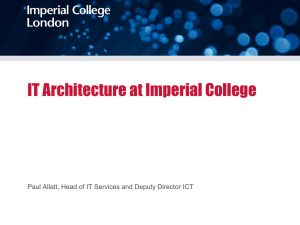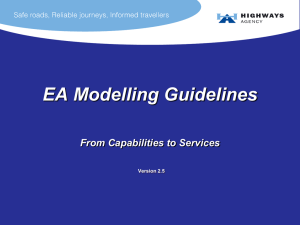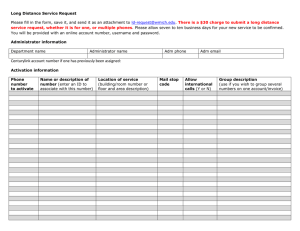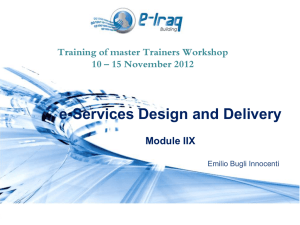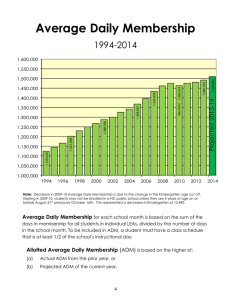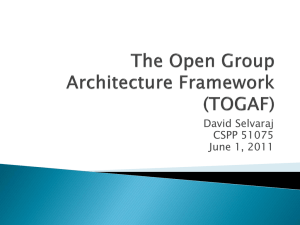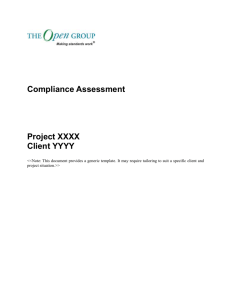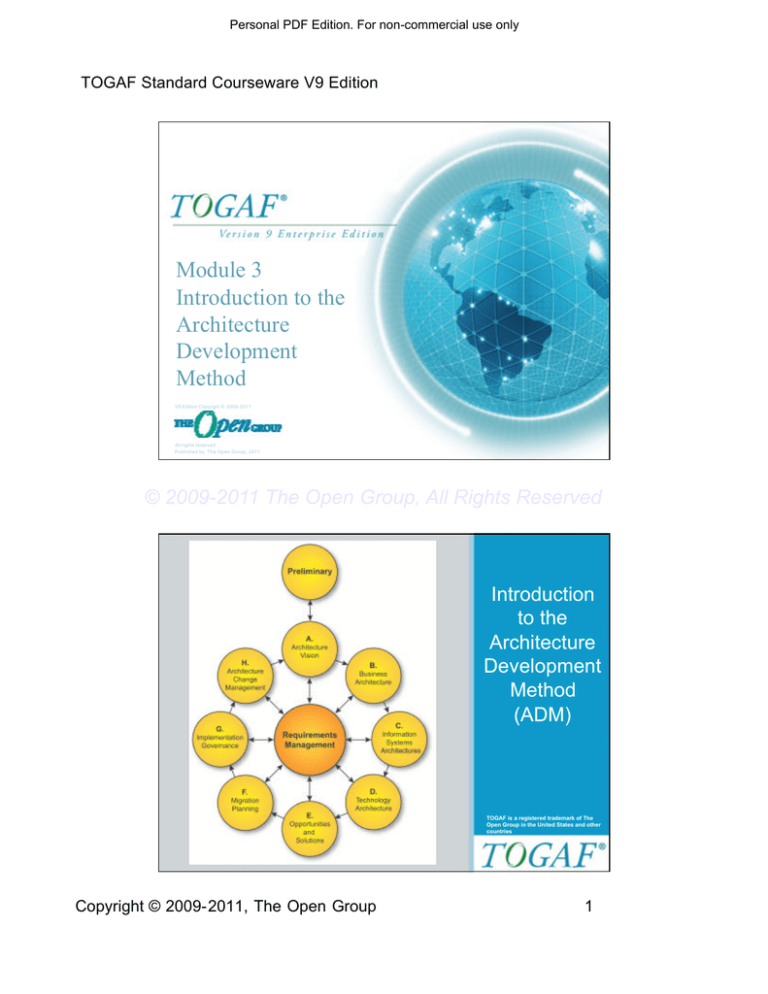
Personal PDF Edition. For non-commercial use only
TOGAF Standard Courseware V9 Edition
Module 3
Introduction to the
Architecture
Development
Method
V9 Edition Copyright © 2009-2011
Slide 1 of 19
All rights reserved
Published by The Open Group, 2011
© 2009-2011 The Open Group, All Rights Reserved
Introduction
to the
Architecture
Development
Method
(ADM)
TOGAF is a registered trademark of The
Open Group in the United States and other
countries
Slide 2 of 19
Copyright © 2009-2011, The Open Group
1
Personal PDF Edition. For non-commercial use only
TOGAF Standard Courseware V9 Edition
Module Objectives
The objectives of this module are to describe:
• The TOGAF ADM
• Its relationship to other parts of TOGAF
• The phases of the ADM
• How and why to adapt the ADM
• How to scope an architecture activity
• The need for an integration framework
Slide 3 of 19
© 2009-2011 The Open Group, All Rights Reserved
What is the TOGAF ADM?
•
The ADM forms the core of TOGAF
•
The result of contributions from many architecture practitioners
•
It is specifically designed to address enterprise’s business and IT
needs by providing:
–
A set of architecture views (business, data, application, technology)
–
Guidelines on tools for architecture development
–
A set of recommended deliverables
–
Links to practical case studies
–
A method for managing requirements
Slide 4 of 19
Copyright © 2009-2011, The Open Group
2
Personal PDF Edition. For non-commercial use only
TOGAF Standard Courseware V9 Edition
Architecture Development Method –
Process
• The ADM is an iterative
process:
– Over the whole process
– Between phases
– Within phases
• For each iteration, reconsider:
– Scope
– Detail
– Schedules, milestones
Slide 5 of 19
© 2009-2011 The Open Group, All Rights Reserved
Architecture Development Method –
Process
• Consider assets from:
– Previous iterations
– Marketplace, according
to availability,
competence, and value:
• Other frameworks
• Systems models
• Vertical Industry models
Slide 6 of 19
Copyright © 2009-2011, The Open Group
3
Personal PDF Edition. For non-commercial use only
TOGAF Standard Courseware V9 Edition
Relationship to other Parts of TOGAF
The ADM forms the core of TOGAF
It is supported by the other main parts of TOGAF:
– ADM Guidelines and Techniques
• Set of guidelines, templates, checklists
– Architecture Content Framework
– The Enterprise Continuum
• Framework and context for architecture assets including
descriptions, models and patterns
– TOGAF Reference Models
– The Architecture Capability Framework
Slide 7 of 19
© 2009-2011 The Open Group, All Rights Reserved
Prepare the organization for a
successful architecture project
Set the scope, constraints and
expectations for a TOGAF project;
create the Architecture Vision;
validate the business context; create
the Statement of Architecture Work
ADM Phases
Provide continual monitoring and a
change management process to
ensure that the architecture
responds to the needs of the
enterprise
Provide architectural oversight
for the implementation; ensure
that the implementation
project conforms to the
architecture
Analyze costs, benefits and
risks; develop detailed
Implementation and
Migration Plan
Ensure that very stage of a
TOGAF project is based on and
validates business requirements
Slide 8 of 19
Copyright © 2009-2011, The Open Group
Develop Business
Architecture
Develop baseline and target
architectures and
analyze the gaps
Develop Information
Systems Architectures
Develop baseline and
target architectures and
analyze the gaps
Develop Technology
Architecture
Develop baseline and target
architectures and
analyze the gaps
Perform initial implementation
planning; identify major
implementation projects
4
Personal PDF Edition. For non-commercial use only
TOGAF Standard Courseware V9 Edition
ADM Phase Steps Example
The order of the steps
should be adapted to
the situation.
In particular you should
determine whether it is
appropriate to do the
Baseline Business
Architecture or Target
Business Architecture
development first
Phase B Steps
9. Create Architecture
Definition Document
8. Finalize the Business
Architecture
7. Conduct formal stakeholder review
6. Resolve impacts across the
Architecture Landscape
5. Define roadmap components
4. Perform gap analysis
3. Develop Target Business Architecture Description
2. Develop Baseline Business Architecture Description
1. Select reference models, viewpoints, and tools
TM
Slide 1 0 of 14
Slide 9 of 19
© 2009-2011 The Open Group, All Rights Reserved
ADM Inputs and Outputs
• TOGAF defines a number of input and output
deliverables for each phase
– These are suggestions and need not be followed exactly
– Output of an early phase may be modified in a later phase
– Version numbers are used to manage the output
– A convention is used to illustrate the evolution of deliverables
• 0.1 – a high level outline deliverable
• 1.0 – a formally reviewed detailed deliverable
Slide 10 of 19
Copyright © 2009-2011, The Open Group
5
Personal PDF Edition. For non-commercial use only
TOGAF Standard Courseware V9 Edition
Adapting the ADM
• Generic methodology intended for variable:
– Geographies
– Vertical sectors
– Industry types
• Usable with deliverables of other frameworks such
as Zachman, DODAF, …
• It is usual to modify or extend the ADM to suit specific
needs
Slide 11 of 19
© 2009-2011 The Open Group, All Rights Reserved
Governing the ADM
• The ADM, whether adapted or used as is, is a key process
to be managed and governed
• The Architecture Board should be satisfied that the method
is being applied correctly
• The management of all architectural artifacts, governance
and related process should be supported by a controlled
environment such as a repository
Slide 12 of 19
Copyright © 2009-2011, The Open Group
6
Personal PDF Edition. For non-commercial use only
TOGAF Standard Courseware V9 Edition
Governance Repository
• Reference Data
• Process Status
• Audit Information
Slide 13 of 19
© 2009-2011 The Open Group, All Rights Reserved
Reasons to constrain the Scope of
Architectural Activity
• The organizational authority of the team producing the
architecture
• The objectives and stakeholder concerns to be addressed
within the architecture
• The availability of people, finance, and other resources
Slide 14 of 19
Copyright © 2009-2011, The Open Group
7
Personal PDF Edition. For non-commercial use only
TOGAF Standard Courseware V9 Edition
Scoping the Architecture Activity
• There are four dimensions in which scope may be
limited:
– Enterprise scope or focus
– Architecture domains
– Vertical scope (level of detail)
– Time periods (Project Schedule)
Slide 15 of 19
© 2009-2011 The Open Group, All Rights Reserved
Architecture Integration
• There is a need to provide an integration framework that
sits above individual architectures:
– To allow the architect to understand how components fit into the
framework
– To derive the architectural models that focus on enterprise-level
capabilities
– To define the conformance standards that enable the integration of
components for maximum leverage and re-use
• An “Enterprise framework” – a Content Framework, or a
Meta-architecture framework
Slide 16 of 19
Copyright © 2009-2011, The Open Group
8
Personal PDF Edition. For non-commercial use only
TOGAF Standard Courseware V9 Edition
Summary
• The ADM is a comprehensive, general method
• It recommends a sequence for various phases and steps
involved in developing an architecture
• It is an iterative method
• It draws on the other parts of TOGAF for assets and
processes
• It can be used with other deliverables from other
frameworks
Slide 17 of 19
© 2009-2011 The Open Group, All Rights Reserved
Test Yourself Question
Q. The following statements describe the phases of the ADM,
except ?
A. They are cyclical.
B. They are iterative.
C. Each phase refines the scope.
D. Each phase is mandatory.
E. The phases cycle through a range of architecture views.
Slide 18 of 19
Copyright © 2009-2011, The Open Group
9
Personal PDF Edition. For non-commercial use only
TOGAF Standard Courseware V9 Edition
Introduction
to the
Architecture
Development
Method
(ADM)
TOGAF is a registered trademark of The
Open Group in the United States and other
countries
Slide 19 of 19
© 2009-2011 The Open Group, All Rights Reserved
Copyright © 2009-2011, The Open Group
10

